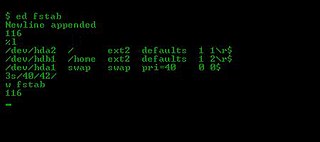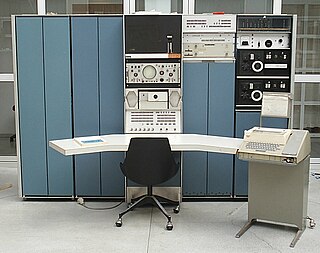Related Research Articles

Brian Wilson Kernighan is a Canadian computer scientist.
B is a programming language developed at Bell Labs circa 1969 by Ken Thompson and Dennis Ritchie.

Dennis MacAlistair Ritchie was an American computer scientist. He is best known for creating the C programming language and, with long-time colleague Ken Thompson, the Unix operating system and B programming language. Ritchie and Thompson were awarded the Turing Award from the ACM in 1983, the Hamming Medal from the IEEE in 1990 and the National Medal of Technology from President Bill Clinton in 1999. Ritchie was the head of Lucent Technologies System Software Research Department when he retired in 2007. He was the "R" in K&R C, and commonly known by his username dmr.

ed is a line editor for Unix and Unix-like operating systems. It was one of the first parts of the Unix operating system that was developed, in August 1969. It remains part of the POSIX and Open Group standards for Unix-based operating systems, alongside the more sophisticated full-screen editor vi.

Multics is an influential early time-sharing operating system based on the concept of a single-level memory. Nathan Gregory writes that Multics "has influenced all modern operating systems since, from microcomputers to mainframes."

The PDP-7 was an 18-bit minicomputer produced by Digital Equipment Corporation as part of the PDP series. Introduced in 1964, shipped since 1965, it was the first to use their Flip-Chip technology. With a cost of US$72,000, it was cheap but powerful by the standards of the time. The PDP-7 is the third of Digital's 18-bit machines, with essentially the same instruction set architecture as the PDP-4 and the PDP-9.
Joseph Frank Ossanna, Jr. was an electrical engineer and computer programmer who worked as a member of the technical staff at the Bell Telephone Laboratories in Murray Hill, New Jersey. He became actively engaged in the software design of Multics, a general-purpose operating system used at Bell.
roff is a typesetting markup language. As the first Unix text-formatting computer program, it is a predecessor of the nroff and troff document processing systems.

Malcolm Douglas McIlroy is a mathematician, engineer, and programmer. As of 2019 he is an Adjunct Professor of Computer Science at Dartmouth College. McIlroy is best known for having originally proposed Unix pipelines and developed several Unix tools, such as spell, diff, sort, join, graph, speak, and tr. He was also one of the pioneering researchers of macro processors and programming language extensibility. He participated in the design of multiple influential programming languages, particularly PL/I, SNOBOL, ALTRAN, TMG and C++.

General Comprehensive Operating System is a family of operating systems oriented toward the 36-bit GE-600 series and Honeywell 6000 series mainframe computers.

The Unix philosophy, originated by Ken Thompson, is a set of cultural norms and philosophical approaches to minimalist, modular software development. It is based on the experience of leading developers of the Unix operating system. Early Unix developers were important in bringing the concepts of modularity and reusability into software engineering practice, spawning a "software tools" movement. Over time, the leading developers of Unix established a set of cultural norms for developing software; these norms became as important and influential as the technology of Unix itself, and have been termed the "Unix philosophy."
Robert H. Morris Sr. was an American cryptographer and computer scientist.
Project Genie was a computer research project started in 1964 at the University of California, Berkeley. It produced an early time-sharing system including the Berkeley Timesharing System, which was then commercialized as the SDS 940.

The C Programming Language is a computer programming book written by Brian Kernighan and Dennis Ritchie, the latter of whom originally designed and implemented the C programming language, as well as co-designed the Unix operating system with which development of the language was closely intertwined. The book was central to the development and popularization of C and is still widely read and used today. Because the book was co-authored by the original language designer, and because the first edition of the book served for many years as the de facto standard for the language, the book was regarded by many to be the authoritative reference on C.

Space Travel is an early video game developed by Ken Thompson in 1969 that simulates travel in the Solar System. The player flies their ship around a two-dimensional scale model of the Solar System with no objectives other than to attempt to land on various planets and moons. The player can move and turn the ship, and adjust the overall speed by adjusting the scale of the simulation. The ship is affected by the single strongest gravitational pull of the astronomical bodies.

The history of Unix dates back to the mid-1960s, when the Massachusetts Institute of Technology, AT&T Bell Labs, and General Electric were jointly developing an experimental time-sharing operating system called Multics for the GE-645 mainframe. Multics introduced many innovations, but also had many problems. Bell Labs, frustrated by the size and complexity of Multics but not its aims, slowly pulled out of the project. Their last researchers to leave Multics – among them Ken Thompson, Dennis Ritchie, Doug McIlroy, and Joe Ossanna – decided to redo the work, but on a much smaller scale.
The Berkeley Timesharing System was a pioneering time-sharing operating system implemented between 1964 and 1967 at the University of California, Berkeley. It was designed as part of Project Genie and marketed by Scientific Data Systems for the SDS 940 computer system. It was the first commercial time-sharing which allowed general-purpose user programming, including machine language.

Unix is a family of multitasking, multi-user computer operating systems that derive from the original AT&T Unix, whose development started in 1969 at the Bell Labs research center by Ken Thompson, Dennis Ritchie, and others.

Kenneth Lane Thompson is an American pioneer of computer science. Thompson worked at Bell Labs for most of his career where he designed and implemented the original Unix operating system. He also invented the B programming language, the direct predecessor to the C programming language, and was one of the creators and early developers of the Plan 9 operating system. Since 2006, Thompson has worked at Google, where he co-developed the Go programming language.

In computing TMG (TransMoGrifier) is a recursive descent compiler-compiler developed by Robert M. McClure and presented in 1965. TMG ran on systems including OS/360 and early Unix. It was used to build EPL, an early version of PL/I.
References
- ↑ "A History of UNIX before Berkeley".
- ↑ Lampson, Butler (January 12, 2007), "Systems", Microsoft Research , archived from the original on 2008-04-13, retrieved 2008-04-05.
- ↑ cf. Angluin, Dana C.; Deutsch, L. Peter (March 26, 1968), Reference Manual: Q. E. D. Time-Sharing Editor (PDF), Washington: Office of Secretary of Defence, archived (PDF) from the original on 2017-12-01.
- ↑ van Dam, Andries; Rice, David E. (1971), "On-line Text Editing: A Survey", ACM Computing Surveys, 3 (3): 93–114, doi:10.1145/356589.356591, S2CID 3142185 .
- ↑ Deutsch, L. Peter; Lampson, Butler W. (1967), "An online editor", Communications of the ACM, 10 (12): 793–799, 803, doi: 10.1145/363848.363863 , p. 793.
- ↑ D. M. Ritchie and K. L. Thompson, "QED Text Editor", MM-70-1373-3 (June 1970), reprinted as "QED Text Editor Reference Manual", MHCC-004, Murray Hill Computing, Bell Laboratories (October 1972).
- ↑ B. W. Kernighan, "A Tutorial Introduction to the QED Text Editor under GE-TSS", MM-70-1373-6 (June 1970), reprinted as "Tutorial Introduction to QED Text Editor", MHCC-002, Murray Hill Computing, Bell Laboratories (October, 1972).
- ↑ B. W. Kernighan, "A Guide to the Advanced Use of QED Text Editor", MM-70-1373-7 (July 1970), reprinted as "A Guide to Advanced Use of QED Text Editor", MHCC-003, Murray Hill Computing, Bell Laboratories (October, 1972).
- ↑ Ritchie, Dennis (February 12, 2004), An incomplete history of the QED Text Editor, Murray Hill: Bell Labs.
- ↑ Fraser, Peter. "The FRED Text Editor". Thinkage Ltd. Retrieved 1 June 2015.